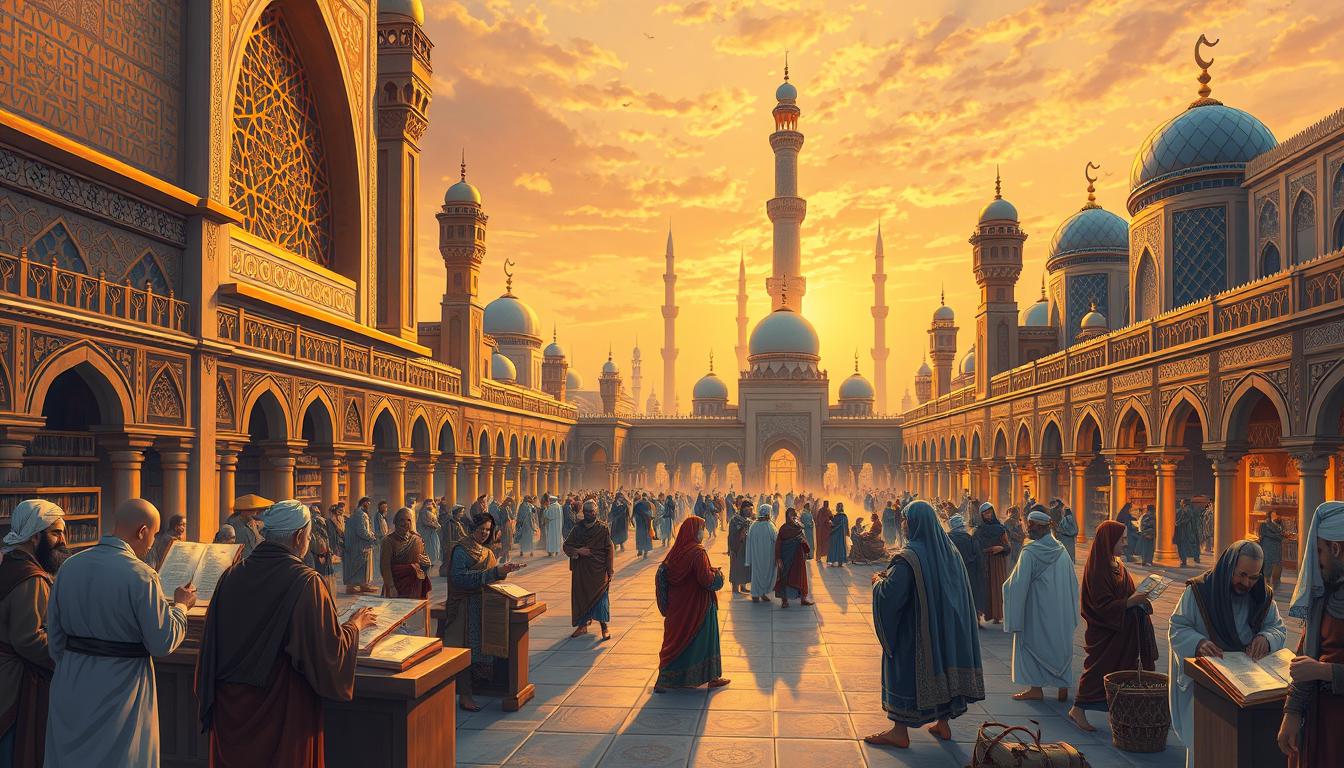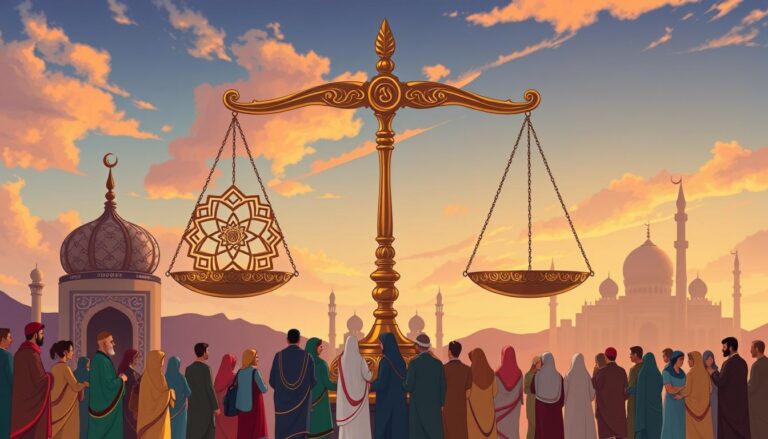How Islam Transformed the Medieval World: Fascinating Facts
Did you know a single civilization once stretched from India to the Atlantic Ocean? This civilization shaped history. The Islamic Golden Age was a time of great innovation and progress. It left a lasting impact on the medieval world.
From the 8th to the 14th century, Islamic civilization thrived. It made big strides in science, philosophy, and the arts. The House of Wisdom in Baghdad, started in 830 CE, was a key moment. Scholars from all over came together to translate and expand ancient knowledge.
Arab scholars made huge discoveries in math, astronomy, and medicine. For example, Ibn Al-Nafis figured out pulmonary circulation 300 years before William Harvey. Ibn Sina’s Canon of Medicine was a key text in European universities for centuries.
The Islamic world’s influence went beyond just learning. Muslim merchants spread their faith and culture along trade routes. They reached as far as Southeast Asia and West Africa. Cities like Timbuktu became centers of learning and commerce. Architectural wonders like the Great Mosque of Jenne showed the artistic skill of Islamic civilization.
Key Takeaways
- The Islamic Golden Age spanned from the 8th to the 14th century
- Baghdad’s House of Wisdom was a pivotal center for knowledge translation
- Muslim scholars made significant advances in various scientific fields
- Islamic medicine introduced concepts still used in modern healthcare
- Trade routes facilitated the spread of Islam to Southeast Asia and West Africa
- Islamic architecture and art left lasting impressions on world culture
The Rise of Islamic Civilization
In 610 CE, Islam was born. Prophet Muhammad’s messages started a spiritual movement. This movement quickly spread across the Arabian Peninsula.
This fast growth laid the groundwork for the Islamic Empire. It changed the medieval world.
The Birth of Islam and Its Rapid Expansion
Muslim expansion was quick and wide. In just a century after Muhammad’s death in 632, the Islamic Empire reached from Spain to India. This was due to military victories and the draw of Islamic teachings.
The Establishment of the Islamic Empire
The Islamic Empire began under the Rashidun Caliphs. These early leaders united power and paved the way for future dynasties. The Caliphate system combined religious and political power in a unique way.
Key Dynasties: Umayyads and Abbasids
The Umayyads ruled from 661 to 750, expanding the empire further. The Abbasids took over, moving the capital to Baghdad in 762. Under the Abbasids, the empire saw a golden age of learning and culture.
- The Umayyads expanded Islamic territory to its greatest extent
- Abbasids fostered intellectual growth and scientific advancements
- Baghdad became a center of knowledge, attracting scholars from diverse backgrounds
This era marked the rise of a sophisticated Islamic civilization. It mixed Arab, Persian, and other cultures. This blend created a rich world of art, science, and philosophy that shaped the world for centuries.
The Golden Age of Islam: A Period of Intellectual Renaissance
The Islamic Golden Age lasted from the 8th to the 13th century. It was a time of great Scientific Advancements and Cultural Impacts. Muslim territories became centers of knowledge and innovation, attracting scholars from all over.
Baghdad became a key place for learning under Abbasid caliph Harun al-Rashid. The House of Wisdom, started then, was a hub for translating ancient texts into Arabic and Persian. This effort was so important that it was as costly as today’s research budgets.
Papermaking from China changed how people shared information. It led to more books and public libraries. This made it possible for people to earn a living by writing and selling books.
“The Islamic civilization during this period became a major intellectual center attracting scholars from diverse backgrounds, creating a universal civilization that connected people from various regions.”
Islamic scholars were experts in many fields like agriculture, economics, literature, and law. They wrote about environmental issues like pollution and waste. The Islamic world also introduced important places like public hospitals, universities, and observatories.
- Islamic merchants expanded trade networks, influencing regions from China to Western Africa
- Sufi missionaries spread Islam to Persia, Central Asia, and North Africa
- Islamic ethics encouraged rational and scientific dialogues, fostering intellectual growth
The Cultural Impacts of this golden age were huge. The Islamic Empire was a key player in early globalization. It connected isolated regions and civilizations. From the 7th to the 13th centuries, it was the world leader in economic influence, showing the deep effects of its intellectual renaissance.
How Islam Transformed the Medieval World: Fascinating Facts
The Islamic Golden Age was a time of great scientific and cultural growth. It saw the rise of learning centers that greatly influenced the medieval world.
The House of Wisdom: A Center of Learning
In the 9th century, Baghdad’s House of Wisdom was a hub of knowledge. It had hundreds of thousands of books, more than any European library. Scholars there worked hard to translate and save ancient texts from Greece, Persia, and India.
Preservation and Translation of Ancient Knowledge
Islamic scholars were key in keeping ancient knowledge alive. The Banu ‘l-Munaddjdjim, famous translators, made a big impact. Their work helped connect cultures across the Mediterranean and paved the way for future discoveries.
Advancements in Science, Mathematics, and Medicine
This era saw major scientific breakthroughs. Al-Khwarizmi’s algebra work changed math forever. Ibn Sina’s medical book became a key text in Europe. Islamic astronomers perfected the astrolabe, making timekeeping and navigation more accurate.
- Development of algebra and the decimal system
- Advancements in astronomy and celestial observations
- Pioneering work in anatomy and surgery
Islamic scholars’ work laid the groundwork for Europe’s scientific revolution centuries later. It shows the lasting impact of Islamic civilization on global knowledge and progress.
Islamic Contributions to Philosophy and Literature
The Islamic world made huge contributions to philosophy and literature in the Middle Ages. Islamic Philosophy grew, mixing Greek ideas with Islamic teachings. Scholars like al-Fārābī, Avicenna, and Averroes greatly influenced Western philosophy in many areas.
Arabic Literature reached a golden age. Epic stories like “One Thousand and One Nights” drew in readers. Arabic became the language of science and learning, spreading knowledge far and wide.
The translation of Arabic texts into Latin had a big impact:
- 131 Arabic philosophical texts were translated into Latin
- Translations happened mainly from the 11th to 13th centuries
- Arabic divisions of sciences influenced Latin understanding of disciplines
Averroës, born in 1126 in Córdoba, Spain, was a key figure in Islamic Philosophy. He believed in combining philosophy with religion and saw logic as key to understanding faith. His ideas were seen as too radical, leading to his banishment and the burning of his works.
“Truth does not contradict truth.” – Averroës
The Islamic Golden Age, from the 8th to 13th century, was a time of great learning. Scholars were well-supported, earning salaries like today’s athletes. This period of intellectual growth left a lasting impact on philosophy and literature worldwide.
Architectural Marvels of the Islamic World
Islamic architecture has made a lasting impact on the world. It includes grand mosques and intricate palaces. These structures show the beauty and creativity of Muslim builders and artists.
The Development of Islamic Architecture
Islamic architecture grew over centuries, mixing styles from Roman, Byzantine, and Persian. The first mosque, built by Muhammad in Medina in 622, was a starting point. As Islam grew, new features like minarets and muqarnas were added.
Iconic Structures and Their Influence
The Dome of the Rock in Jerusalem, built in 691 CE, is a key example of early Islamic architecture. Its design and golden dome are iconic. The Great Mosque of Córdoba, built in 784, is famous for its unique horseshoe arch.
Artistic Elements in Islamic Buildings
Mosque design often features intricate geometric patterns and calligraphy. These elements highlight unity and harmony, core principles in Islamic art. The use of arabesques and complex forms creates stunning interiors.
- The Taj Mahal took over 20 years to complete
- The Alhambra palace in Granada dates back to the 14th century
- The Great Mosque of Samarra once covered nearly 42 acres
From the Suleymaniye Mosque in Istanbul to the Friday Mosque in Esfahan, Islamic architecture continues to inspire. These buildings show the rich cultural heritage of the Islamic world.
Economic Prosperity and Trade Networks
The Islamic world experienced significant economic growth through its vast trade routes. These routes connected China to Europe and Africa, forming a vast network of commerce. Cities like Baghdad, Cairo, and Cordoba became major commercial centers, drawing merchants from all over.
Islamic traders handled a wide variety of goods. Spices, textiles, precious metals, and scientific tools were just a few examples. The invention of financial tools like the suftaja made trade across long distances safer and more efficient.
Studies reveal a strong connection between old trade networks and today’s Muslim populations. This shows how trade helped spread Islam. Countries near these ancient routes often have larger Muslim communities now.
- Islam spread well in areas like the Arabian Peninsula
- Geographic inequality boosted Muslim presence
- Islamic trade principles led to conversions in thriving trade areas
The economic growth from these trade networks had a big impact. It helped cities grow and supported advances in arts and sciences. By the 11th century, Islamic cities had many hospitals, thanks to charitable trusts. This prosperity set the stage for the Islamic Golden Age, a time of great intellectual and cultural achievements.
Cultural Exchange and Religious Tolerance
The Islamic world during its Golden Age was a melting pot of cultures and religions. This period saw remarkable cultural exchange and religious tolerance. It shaped the medieval world in profound ways.
Interfaith Dialogue and Coexistence
Islamic societies fostered an environment where different faiths could coexist. Muslims, Christians, and Jews lived side by side in many cities. This created a rich tapestry of ideas and cultures.
This atmosphere of religious tolerance encouraged scholarly exchange and intellectual growth.
The Influence of Islam on European Culture
Islamic culture left a lasting mark on European art, architecture, and science. This influence was especially strong in Spain and Sicily. Contact between Islamic and European cultures was most direct there.
The translation of Arabic texts into Latin played a crucial role. It sparked the European Renaissance.
Multicultural Societies in Islamic Territories
Islamic territories were home to vibrant multicultural societies. In cities across the empire, people from diverse backgrounds lived and worked together. This created a unique cultural landscape.
This diversity fueled innovation and creativity in fields like science and literature.
“Islam is a religion of equilibrium and tolerance, emphasizing a breadth of vision and global positions.”
The cultural exchange and religious tolerance of the Islamic Golden Age had far-reaching effects. It enriched Islamic civilization and contributed significantly to European culture and science. It laid the groundwork for future advancements in human knowledge.
Influential Muslim Scholars and Their Lasting Impact
The Islamic Golden Age was a time of great change. Many Muslim scientists and scholars made huge impacts on our knowledge. They worked in fields like mathematics and medicine, helping science grow for centuries.
Al-Khwarizmi, from the 9th century, changed math forever. He created algebra, a key part of math today. His book, “al-Kitab al-mukhtasar fi hisab al-jabr wa’l-muqabala,” started the word “algebra.”
Ibn Sina, or Avicenna, was a key figure in medicine. His “Canon of Medicine” was a top book in Europe for ages. Born in 980, his work showed how advanced Islamic medicine was.
- Ibn al-Haytham made big discoveries in optics
- Al-Biruni helped in astronomy, geography, and anthropology
- Al-Farabi made big steps in philosophy, politics, and music
These scientists didn’t just help the Islamic world. They also changed science and thought in Europe. Their work, translated into Latin in the 12th century, helped spark growth in medieval Europe. This growth led to the Renaissance.
“The ink of the scholar is more sacred than the blood of the martyr.” – Prophet Muhammad
Ibn Khaldun, born in 1332, also left a big mark. His “Muqaddimah” was a key work in history and sociology. His thoughts on society and history still influence us today.
Conclusion
The Islamic Legacy had a lasting impact on the Medieval World. It began when Muhammad founded Islam in the late sixth century CE. From then until the Arabian Nights era, from 700 to 1000 CE, Islam spread far and wide.
At its peak, Islamic civilization reached from India to the Atlantic Ocean. It created a rich mix of knowledge and innovation. This period was filled with growth and discovery.
The “House of Wisdom” in Baghdad, established in 830 CE, marked a golden age of learning. Arab scholars made huge strides in math, astronomy, and medicine. Their work was so important that Arabic became the main scientific language for centuries.
Medicine saw big changes, like separate hospital wards and the start of pharmacies. This was a key part of the Islamic Legacy in medicine.
This time wasn’t just about science. Islamic architecture, literature, and art also thrived. They created a cultural renaissance that touched Europe and more.
The Islamic civilization’s influence was so strong that even after it declined, its legacy kept shaping the world. Looking back at this era teaches us about the power of sharing knowledge and cultural connections. These things drive human progress.
Source Links
- How Islam changed medicine: Arab physicians and scholars laid the basis for medical practice in Europe
- Did you know?: The Spread of Islam in Southeast Asia through the Trade Routes
- The Spread of Islam in West Africa: Containment, Mixing, and Reform from
- Islamic world contributions to Medieval Europe
- The Early Modern Islamic World
- Islamic Golden Age
- Islamic Golden Age | Islamic History
- How Islamic Learning Transformed Western Civilization: Review of ‘The House of Wisdom’ – Muslim Heritage
- Islamic Art and Culture: The Venetian Perspective | Essay | The Metropolitan Museum of Art | Heilbrunn Timeline of Art History
- Influence of Arabic and Islamic Philosophy on the Latin West
- The Islamic Golden Age | World Civilization
- The Islamic Scholar Who Gave Us Modern Philosophy
- 8 Masterpieces of Islamic Architecture | Britannica
- Everything to know about Islamic Architecture and Its Global Influence
- Islamic architecture
- Trade and Geography in the Spread of Islam
- Trade and the Spread of Islam in Africa | Essay | The Metropolitan Museum of Art | Heilbrunn Timeline of Art History
- History of Islamic economics
- Spread of Islam
- Islam and Western Culture
- Crusades – Religious Conflict, Legacy, Impact | Britannica
- Top 20 Islamic Scholars in History: Work and Impact
- Mathematics in the medieval Islamic world
- The Impact of Islam
- Middle Ages ‑ Definition, Timeline & Facts
- The Nature and Triumph of Islam







